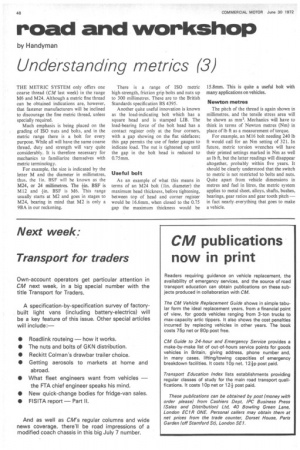road and workshop
Page 50

If you've noticed an error in this article please click here to report it so we can fix it.
by Handyman
Understanding metrics (3)
THE METRIC SYSTEM only offers one coarse thread (CM last week) in the range M6 and M24. Although a metric fine thread can be obtained indications are, however, that fastener manufacturers will be inclined to discourage the fine metric thread, unless specially required.
Much emphasis is being placed on the grading of ISO nuts and bolts, and in the metric range there is a bolt for every purpose. While all will have the same coarse thread, duty and strength will vary quite considerably. It is therefore necessary for mechanics to familiarize themselves with metric terminology.
For example, the size is indicated by the letter M and the diameter in millimetres, thus, the lin. BSF will be known as the M24, or 24 millimetres. The fin. BSF is MI2 and fin. BSF is M6. This range usually starts at M2 and goes in stages to M24, bearing in mind that M2 is only a 9BA in our reckoning.
There is a range of ISO metric high-strength, friction grip bolts and nuts up to 300 millimetres, These are to the British Standards specification BS 4395.
Another quite useful innovation is known as the load-indicating bolt which has a square head and is stamped LIB. The load-bearing force of the bolt head has a contact register only at the four corners, with a gap showing on the flat sidefaces; this gap permits the use of feeler gauges to indicate load. The nut is tightened up until the gap in the bolt head is reduced to 0.75mm.
Useful bolt As an example of what this means in terms of an M24 bolt (lin. diameter) the maximum head thickness, before tightening, between top of head and corner register would be 16.6mm, when closed to the 0.75 gap the maximum thickness would be
15.8mm. This is quite a useful bolt with many applications on vehicles.
Newton metres The pitch of the thread is again shown in millimetres, and the tensile stress area will be shown as mm2. Mechanics will have to think in terms of Newton metres (Nm) in place of lb ft as a measurement of torque.
For example, an M16 bolt needing 240 lb ft would call for an Nm setting of 321. In future, metric torsion wrenches will have their printed settings marked in Nm as well as lb ft, but the latter readings will disappear altogether, probably within five years. It should be clearly understood that the switch to metric is not restricted to bolts and nuts. Quite apart from vehicle dimensions in metres and fuel in litres, the metric system applies to metal sheet, alloys, shafts, bushes, bearings, gear ratios and gear tooth pitch — in fact nearly.everything that goes to make a vehicle.




























































































